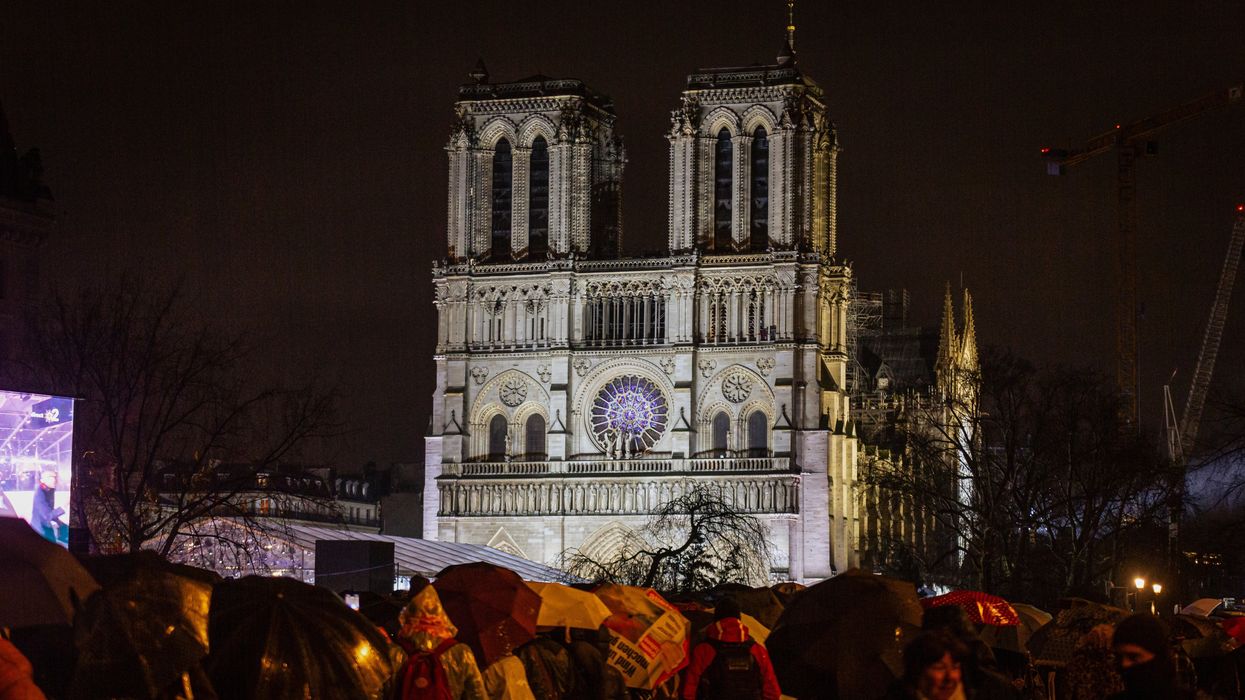We witnessed a marvel in Paris this weekend.
When a devastating 2019 fire nearly brought Notre Dame Cathedral to the ground, President Emanuel Macron set the ostensibly impossible goal of restoring and reopening the 860-year-old Gothic masterpiece within five years. Restorations on that scale usually take decades. It took almost 200 years to complete the cathedral in the first place, starting in 1163 during the Middle Ages.
Could Macron’s audacious challenge — made while the building was still smoldering — be met?
In the weeks following the disaster, more than 340,000 donors responded to Macron’s clarion call by contributing over $900 million in restoration funds. Under his direction, an extraordinarily talented leadership team led by Philippe Jost marshaled 250 companies and painstakingly coordinated a vastly complex endeavor. Thousands of workers who have dedicated their entire careers to restoration came out of the woodwork.
In addition to the financial resources, Macron’s appeal ignited a passion in these 2,000 workers, many meticulously trained artisans, to rise up to the challenge. As an indication of their level of devotion, the onslaught of the devastating Covid-19 pandemic (less than a year following the commencement of the restoration work) would only hinder but not foil their efforts.
To avoid any doubt regarding just how miraculous this feat was, please read The New York Times’ wonderfully detailed profile of the overall effort as well as an illustration of the power of Notre Dame’s symbolism throughout the world. The Times described the effort to reconstruct the lattice-like roofing structure dubbed “the forest,” originally sourced from timber of 800-year-old trees:
“Each oak tree had been selected to match the contours of the ancient beam it would replace. The tree was then carved to duplicate the peculiarities of the hand-tooled silhouette of the original, with the medieval carpenter’s mark even tattooed back onto it. ‘Faithful’ only began to describe the effort, which was not for show. The public won’t get to see the rafters that are now behind the restored ceiling vaults.”
The history of cathedral is so rich that Victor Hugo advocated for its preservation and lauded its significance in France's cultural heritage in his famous novel “The Hunchback of Notre-Dame,” published almost 200 years ago. Under its now restored roof, Mary Queen of Scots was married, Joan of Arc beatified, Napoleon crowned and Charles de Gaulle celebrated. The cathedral has been so central to France that it serves as ground zero from which all distances in the nation are measured.
We must not fail to recognize the symbolism of this astonishing and successful venture. Notre Dame is not only among France’s most cherished institutions; it is arguably one of the greatest accomplishments of western civilization. What does its miraculous rebirth represent in a 21st century ravaged by war and destruction, where zeitgeist forces seem all too eager to demolish rather than preserve and reform our institutions? As the Times reports, “For a wider world, it underscores that calamities are surmountable, that some good and true things endure — that humanity may not yet have lost touch with its best self.”
During this same past weekend a different set of activities was proceeding on this side of the Atlantic. In Palm Beach, Florida, President-elect Donald Trump’s transition team has been busy mapping out its plans for the new administration. Trump is surrounded by both loyalty-hardened advisors and a fresh group of tech-wealthy oligarchs lining up to do his bidding. We now hand over leadership of American institutions to these latest stewards.
As I have frequently written about in this series, the leaders of many of our current institutions must be held accountable for their failures. The most effective institutions need to be respected, but can only be sustained through adaptation and modernization. As David Brooks wrote recently, “Over the course of our lives, we inherit institutions, steward them and try to pass them along in better shape to the next generation. We know our institutions have flaws and need reform, but we regard them as fundamentally legitimate.”
So what concerns me is the level of disdain that Trumpism in general seems to hold for these same institutions. At almost every turn, the MAGA minions have willingly attacked both their legitimacy and the kinds of people who work for them. In a Substack essay, Damon Linker writes: “Trumpism is seeking to advance a revolutionary transvaluation of values by inverting the morality that undergirds both traditional conservatism and liberal institutionalism. In this inversion, norms and rules that counsel and enforce propriety, restraint and deference to institutional authority become vices, while flouting them become virtues.”
Admittedly, many of our nation’s institutions are led today by an elite establishment positioned left of center that has failed millions of working class Americans over recent decades. But as opposed to endeavoring to increase their representation in the ranks of such institutions with an eye towards reform, politicians in Trump’s reinvented Republican Party have openly degraded and attacked their very legitimacy in recent years. Instead of constructive critique, they openly disparage mainstream media platforms, take control of the governing boards of state university systems and prohibit the teaching of disfavored ideas in public schools. Conservative media sources portray teachers, professors, scientists, journalists and civil servants as ideological enemies to be punished or ignored.
As they sit around the conference room tables at Mar-a-Lago, I imagine many on Trump’s transition team truly believe that tearing down is easier than reforming, preserving and rebuilding. I can only hope that they also watched the reopening of Notre Dame this weekend and heeded the important message illustrated — that the latter is indeed possible if the will is tenacious and paramount.
Radwell is the author of “American Schism: How the Two Enlightenments Hold the Secret to Healing our Nation ” and serves on the Advisory Council at Business for America. This is the 15th entry in what was intended to be a 10-part series on the American schism in 2024.




















